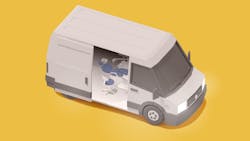Dental care delivery: The changing tide
It’s time to experience dentistry like never before! No matter how you look at it, the dental industry will never be the same. Patients want convenience, providers want flexibility, and dental practice owners want to pandemic-proof their business models. We want less fear and more normalcy, all while continuing to increase the bottom line.
In our pandemic-shifted society, we now must take a closer look at how we interact with our patient—the consumer. Long before the world shut down from COVID-19, the dental patient was already presenting with a more consumer-driven mindset than ever before, all the while asking for transparency, convenience, and flexibility to be top priorities. Generational shifts and innovative technology were two driving factors that had already revolutionized how our patients viewed health-care providers. Throw an unprecedented pandemic into the mix, and the dental patient now demands transparency, convenience, and flexibility from us.
As industry experts and clinicians, it is our hope that the following pages will help guide and inspire you in your practice of dentistry. Whether you read through it with your study club, use it as a handbook, or peruse it on your own, think of this as a guide to future-proof your career and business. The truth is it has never been easier to care for our patients!
The bottom line is this: dentistry was already poised for change. Change was coming—and then came—in the blink of an eye. Now it is up to us to follow through and implement this change for a bright and successful future.
You should know…
- It is estimated that there are now more than 2,000 mobile health clinics in the US.2
- As of 2016, data indicates more than 6.5 million visits take place on mobile health clinics in the US.3
- With the acceleration of consumer and provider adoption of telehealth and extension of telehealth beyond virtual urgent care, up to $250 billion of current US health-care spend could potentially be virtualized.4
- “As the pandemic continues to sharpen our focus of achieving health equity, it is clear the future of health-care delivery will never be quite the same.”5
Where we stand
Virtual care and mobile delivery are currently revolutionizing the landscape of dentistry and are quickly propelling the industry into the future. The concept of providing dental services outside of the traditional four walls of a brick-and-mortar practice is not new. However, recent generational shifts and the residual effects of the COVID-19 pandemic have led to changes in patient mindset and have guided dental professionals to quickly explore nontraditional patient touchpoints.
The great news is the idea of delivering health care to the patient has been around for decades, but what is new is how we deliver care. Technology, apps, mobile phones, and other innovations make it easy to connect with our patients in ways we never thought possible. The telehealth boom of the last decade has provided both the foundation and a path forward for innovative care delivery models in dentistry. For the purpose of this article, we’ll use the phrase nontraditional care delivery when referring as a whole to mobile dentistry, teledentistry, and the innovations to come.
Providing dental care outside of the four walls of the fixed dental practice is a win-win-win scenario for not just the practice owner, but also for the patient and the dental team. Nontraditional care delivery methods provide benefits including increased access to care for patients, practice expansion, and greater profitability for the dental practice while minimizing common overhead (new construction, purchasing an additional practice, etc.), as well as creating a flexible business and career model for the practice owner and team.
Innovative health-care delivery models will continue to evolve, but at this time mobile delivery and virtual care are on the forefront, going together like peanut butter and jelly: you can have one without the other but they are better together! The introduction of telehealth into dentistry has allowed the dental provider to go mobile but stay better connected at the same time.
The most frequently asked question in regard to nontraditional care delivery is How do I get started? While in the past there have been limited resources and support for this, the good news is there are now plenty of reliable resources that have been developed over the course of the past several years.
One of the most popular resources is Velocity Twenty22, the third annual National Mobile & Teledentistry Conference, taking place on March 3–5, 2022, at Sahara Las Vegas. This three-day popular event is geared toward practice owners, teams, and industry brands who are interested in ushering in the future of dental care. With a focus on innovative technology, mobile apps, artificial intelligence, and more, attendees have the chance to get hands-on with equipment and will even be able to explore mobile units as they are displayed in a rooftop showcase! Tickets are on sale now. More information can be found at nmdconference.com.
Along with the conference, other top resources include a professional association, master classes, roundtables, podcasts, social media groups, and more!
Read more: Avoid these potentially fraudulent teledentistry mistakes
How do I get started?
One of the secrets to successfully implementing virtual care is to keep it simple and start small. Pick your favorite patient or easiest appointment of the day and do it virtually! Then try again the next day, and the next day after that. Pretty soon it will become a natural part of the clinical day. Be sure to get creative and think outside of just live-video chat—recorded video, text, and other store-and-forward methods are more convenient for both the patient and provider.
The same rules apply with mobile delivery—keep it simple and start small. Begin with a quick consult in a patient’s home or purchase portable equipment and have a dental hygienist visit the home. Figure out what types of patients you’d like to deliver services to (e.g., elderly, families, millennials), what locations (e.g., home, workplace, schools), and how many days you’ll be sending a provider into the field. Before you know it, valuable in-office chair time will open up, creating space in the daily schedule for more lucrative procedures or for additional team members or specialists.
Here are five easy ways to implement virtual care (in-depth discussion here).1
- Connect with those already implementing teledentistry
- Discover what’s possible for you
- Educate your staff
- Start with one patient
- Incentivize your patients
Read more: The value teledentistry visits bring to dentists and their patients
Most common mobile care delivery models
Mobile dentistry allows the dental professional to think outside the box. As is evidenced throughout the COVID-19 shutdown, the greatest benefit of nontraditional care delivery models is that they can be widely adaptable to the ever-changing needs of a dental practice and a dental patient. Easily scalable, dental practices that provide mobile care can have a presence in one state, a region, or even nationwide. Here are some of the most common types of mobile delivery models:
- Pop-up clinics that treat employees of corporate facilities
- Concierge dentistry to patients’ homes
- Specialty hub-and-spoke models (e.g., an orthodontist with both a brick-and-mortar building plus mobile delivery)
- Mobile vans, pods, RVs, or trailers
- Portable care in schools, nursing homes, or in the home
Gone are the days of providing limited services while going mobile. In fact, mobile clinicians regularly provide comprehensive services, including whitening, aligners, restorative procedures, and more. With tools such as intraoral scanners and cameras, 3D printers, and compact setups, taking comprehensive care to the patient is certainly possible and very much in demand.
The bottom line for the dental industry is this—dental practices that aren’t reaching patients through mobile devices or through mobile services may soon find it difficult to retain existing patients and reach new patients.
Want to know a secret? As an added bonus, there’s a phenomenon that seems to take place when a dental practice implements care outside of the traditional methods: we routinely see an increase in team morale, spirit, and communication. Venturing out of the tiny clinical op may be fun, refreshing, and a welcome adventure to team members! Who knows … maybe this is just what you’re looking for to experience dentistry like never before!
Top resources
- The National Mobile & Teledentistry Conference
- The American Mobile & Teledentistry Alliance
- An Introduction to Modern Mobile & Teledentistry: How Technology, Consumer Demand & Prevention are Shaping the Future of Dentistry
- Dentistry Gone Wild podcast
- I Heart Mobile Dentistry network
- The Geriatric Toothfairy
- Teledentistry for Beginners forum
- Advanced Teledentistry forum
References
- 5 tips on how to incorporate teledentistry services into your dental practice right now. Dent Econ. June 1, 2020. https://www.dentaleconomics.com/science-tech/article/14177520/5-tips-on-how-to-incorporate-teledentistry-services-into-your-dental-practice-right-now
- Impact report: Overview. Mobile Health Map. https://www.mobilehealthmap.org/impact-report
- Yu SWY, Hill C, Ricks ML, Bennet J, Oriol NE. The scope and impact of mobile health clinics in the United States: a literature review. Int J Equity Health. 2017;16(1):178. doi: 10.1186/s12939-017-0671-2
- Bestsennyy O, Gilbert G, Harris A, Rost J. Telehealth: A quarter-trillion-dollar post-COVID-19 reality? McKinsey & Company. July 9, 2021. https://www.mckinsey.com/industries/healthcare-systems-and-services/our-insights/telehealth-a-quarter-trillion-dollar-post-covid-19-reality
- Fitzpatrick L. The future of healthcare is mobile. Forbes. https://www.forbes.com/sites/lisafitzpatrick/2021/01/15/the-future-of-healthcare-is-mobile
Editor's note: This article appeared in the print edition of December 2021 Dental Economics.
About the Author

Sonya Dunbar, MHA, RDH
Sonya Dunbar, MHA, RDH, aka the Geriatric Toothfairy, is a registered dental hygienist, oral health educator and trainer, and national public speaker with over 28 years of experience in private practice, skilled nursing facilities, and academia. Co-owner of Mobile Dental Xpress, Dunbar provides comprehensive dental care to long-term care facilities. A US Navy veteran, she is currently pursuing a PhD in gerontology and is the author of Golden Nuggets for Life and coauthor of the Modern Mobile & Teledentistry and The Tooth & Nothing but the Truth books.
Updated November 4, 2021
Melissa Turner, BASDH, RDHEP, EFDA
Melissa Turner, BASDH, RDHEP, EFDA, is a valued thought leader, dental advisor, and speaker. With extensive experience in both teledentistry and mobile delivery, she is cofounder of the National Mobile Dentistry Conference and the American Mobile Dentistry Alliance. Creator of I Heart Mobile Dentistry, a Facebook networking group for clinicians practicing mobile dentistry, Turner’s passion is to improve the dental experience for patients and providers. Contact her at [email protected].

